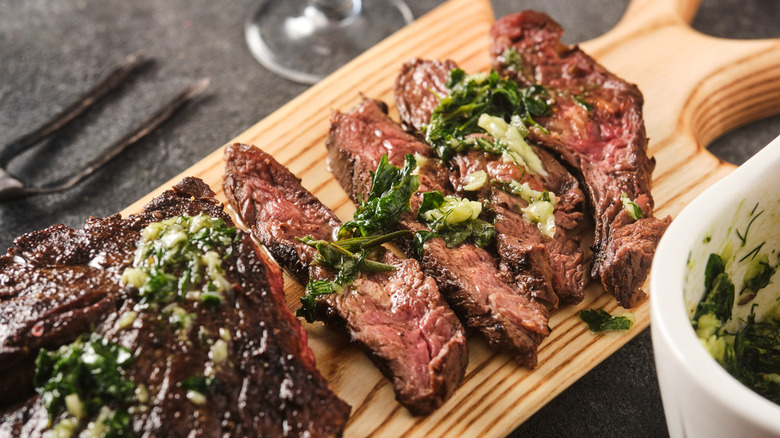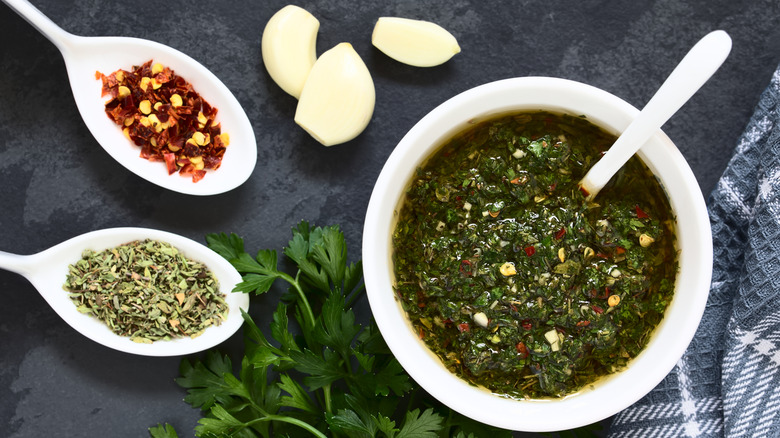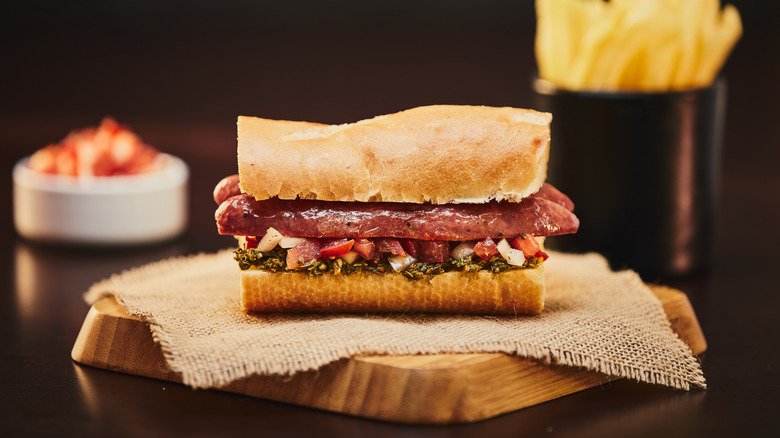What Is Chimichurri And What Should You Spoon It Over?
You can hardly talk about Argentinian cuisine and not mention chimichurri, the bright green herb sauce that makes an appearance at any Argentinian meal that contains meat. As the third largest meat-consuming country in the world, Argentina is famous for its asados, or all forms of meat grilled over a fire. This can be sausages, chicken, or the beef that is plentiful in the country. Unlike many Americans who believe a perfectly cooked steak needs no sauce at all, Argentinians couldn't fathom an absence of chimichurri from even the most pristinely cooked cut of meat.
Chimichurri is an uncooked sauce that resembles Italian pesto but has an entirely different flavor. It's almost grassy with some spice, sharpness, and tartness. Chimichurri provides a delicious contrast to the fat in beef and the richness of sausage.
There are a number of stories of how chimichurri became introduced to Argentina, including an Irish immigrant who developed the sauce in the 1800s when he was trying to recreate the flavor or Worcestershire sauce and captive British soldiers requesting curry from their South American captors. Still others claim that Basque migrants brought the prototype for the sauce with them to Argentina in the early 1900s or that it has been part of Argentinian food culture since the time of the indigenous Quechua people. Whatever is true, one thing is certain: Chimichurri has since spread wide and far over the world. It may be made for meat, but gives amazing flavor to almost anything it touches.
How is chimichurri made?
Chimichurri is a combination of parsley, oregano, chilis, garlic, oil, and vinegar. It can be chopped finely by hand, crushed in a mortar and pestle, or blitzed in a blender or food processor, as long as everything comes together in a cohesive, well-balanced sauce. While there are a number of chimichurri recipes that exist, the combination and amounts of the ingredients varies by whoever is making it. Some may go heavier on the garlic, while others prefer more or less chili spice.
Traditional chimichurri uses dried oregano, but fresh can also be used. While olive oil is a must in Italian pesto and you'll find plenty of chimichurri variations that use the same, others believe the herbal, green flavor of olive oil detracts from the rest of the ingredients and will use a neutral oil instead.
The sauce can be made ahead of time and leftovers can be stored in the refrigerator. But because fresh ingredients are used, it's best to enjoy chimichurri as soon as possible.
Two types, unlimited uses
The most recognized chimichurri is the green version, but there is also a red version that utilizes roasted red peppers and smoked paprika. The green and red sauces can be used interchangeably, and they each are delicious over grilled meats and sausages.
Just about as synonymous with Argentina as chimichurri is a humble sandwich called choripan. Choripan is a casual snack food enjoyed all over the country and several other neighboring countries as well. It consists of a grilled sausage doused with chimichurri, served on a roll. The sauce compliments the smoky sausage and soaks into the soft roll.
Chimichurri can be served with this idea in mind as well. It's a great sauce for dunking bread, similar to the way people enjoy dipping bread into flavored or herbed olive oils. Green or red chimichurri pairs well with empanadas, poured over crispy roasted potatoes, spooned over fish and vegetables, or used as a salad dressing. But it truly shines when eaten with grilled meat. You can serve it on the side or pour it over slices of grilled beef, chicken, venison, pork, or lamb.



